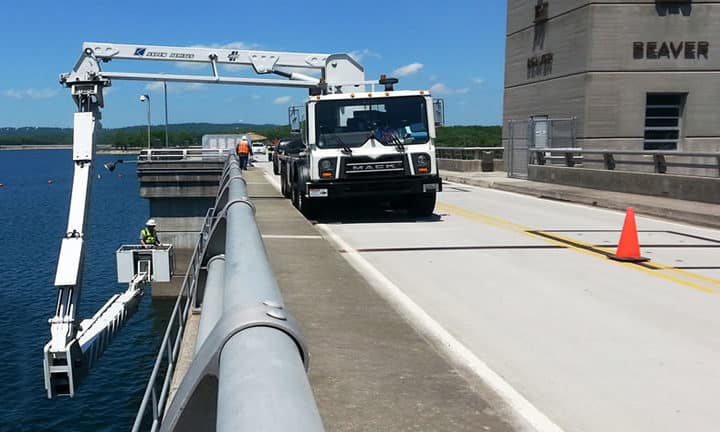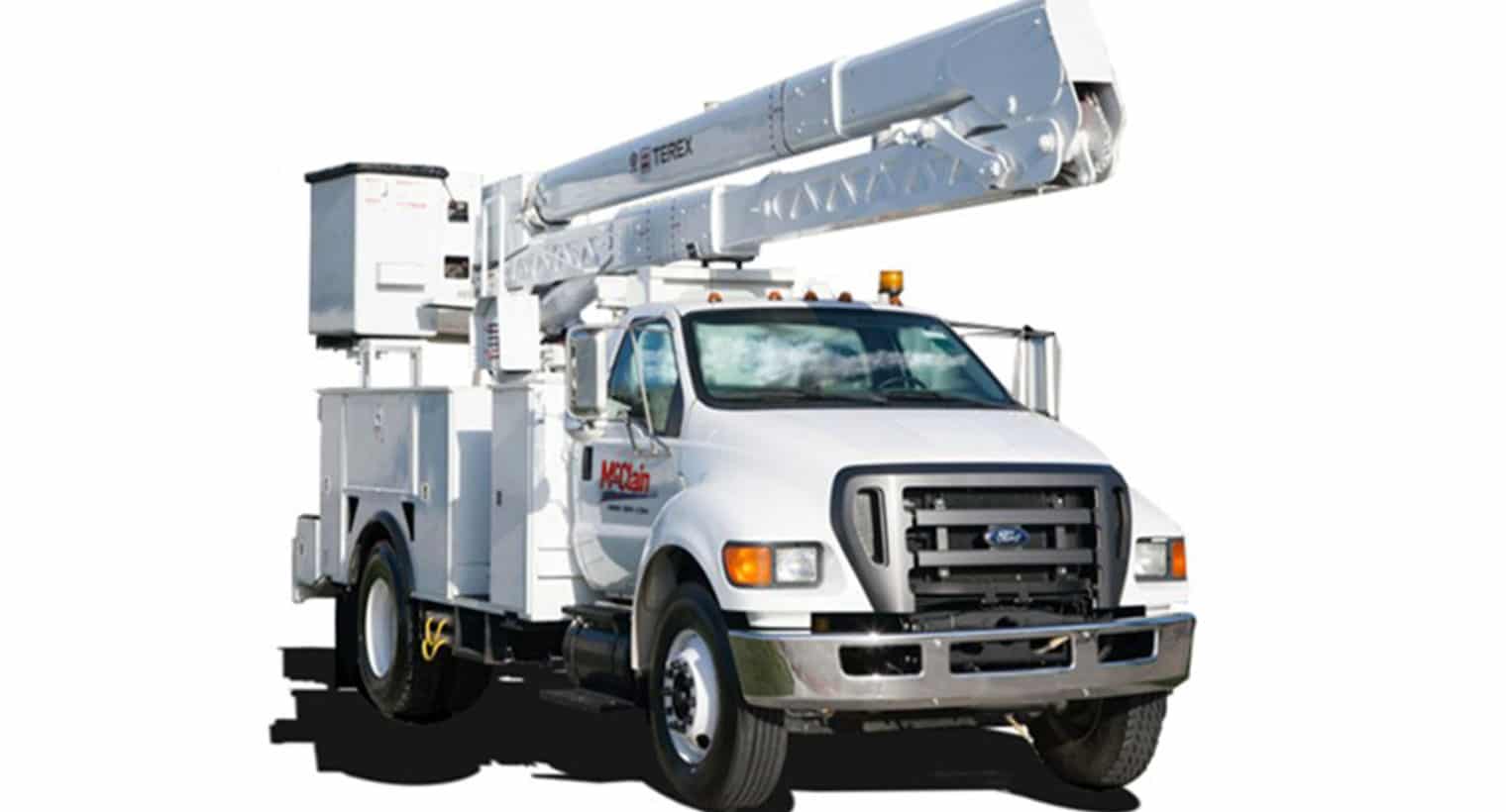Depending on the industry you’re in, the term “bucket truck” might bring to mind different things. For many people, the sight of a utility company boom truck, hoisting a one-man bucket up to the top of a power pole is quite familiar.
But a bucket truck is a far more versatile and varied piece of equipment.
Defining Bucket Trucks
Definitions are often easy to come by, but just as often they can be a bit slippery when applied to actual, real-world objects.
Take bucket trucks, for example.
A simple textbook definition of a bucket truck might go as follows:
An aerial work platform that is a mechanical device used to provide temporary access for people or equipment to inaccessible areas, usually at height.
And, while this is accurate as far as it goes, in practice, bucket trucks can also be used to reach down and under, as is typical for bridge inspections, for example. The venerable Snooper™ truck is a notable example of this type of bucket truck.
In fact, these vehicles are often referred to as cherry pickers, boom trucks, aerial work platforms, aerial devices, elevating work platforms, or mobile elevating work platforms.
Specifically, a bucket truck is a type of aerial lift, or work platform, known as a boom lift.
There are two common types of boom lifts. One is an articulating boom lift that has arms – or booms – that bend to allow navigation around or over objects, also known as jib booms. Telescopic boom lifts, on the other hand, have straight booms that extend outwards.
While articulating booms provide far more versatility and reach, telescopic boom lifts usually provide higher weight capacities, but have less maneuverability.
And, finally, most truck-mounted boom lifts have hydraulically controlled arms with a one, two, or even three person bucket platform attached to the end of the last boom. This work platform may only be capable of holding one worker and a small number of tools or material. Others can hold up to 1,000 pounds of both personnel and equipment.
Bucket Trucks, Cherry Pickers, and ‘Snooper’ Trucks
According to several authors, bucket trucks were originally known as “cherry pickers.”
“The cherry picker, also now referred to as a bucket truck, aerial manlift, and many other names was first developed in the early 1900s as a means for farmers and their workers to pick fruit more safely and without damaging the tree. Though the trucks were used to pick may types of fruit, cherry is the one that stuck as a generic term to refer to bucket trucks and all other manlifts.”
Some historians attribute the first bucket truck to Jay Eitel, the founder of the Telsta Corporation in Sunnyvale, Calif., which produced one of the first aerial lifts for the utility industry.
As one article notes,
“In 1944, Jay spent a tedious summer day picking cherries. After a frustrating day of positioning and repositioning the ladder, the inefficiency of this chore led him to design a device he called the ‘cherry picker.’ On evenings and weekends, he built a highly maneuverable, telescoping, steel structure mounted on a truck chassis with a simple one-lever control.”
Another example is Walter E. Thornton-Trump who, in 1951, invented a boom lift to allow working in high places easier and safer. Thornton-Trump called his boom lift the Giraffe, but the name cherry picker became associated with it as people often used it to pick fruit from tall trees. Mr. Thornton-Trump patented his invention in the early 1960s, calling it a “power-operated boom structure” to be used as a “lifting apparatus for electric line and construction workers.”
Then, in 1964, the first “SNOOPER™” Under Bridge Inspection and Maintenance Truck was designed and manufactured by the Paxton-Mitchell Company, LLC. Since that time, the popularity of the Paxton-Mitchell bucket trucks led to the almost generic use of the term “Snooper” truck.
The cherry picker truck, or bucket truck as we know it today, was quite revolutionary for many industries such as utility companies and arborists. Before the availability of bucket trucks, workers were limited to climbing poles or trees, and using ladders or scaffolding. The bucket truck allowed these industries to become more mobile and made for faster, safer, and more efficient work.
As time went on, the bucket truck evolved with the advent of telescoping boom and, later, articulating booms.
Bucket Trucks in the Field
Bucket trucks are, at their most basic level, simply vehicle mounted work platforms.
And, while they are typically mounted on trucks, they can also be mounted on trailers or industrial vans, as well as self-propelled machines operated remotely by a worker in the bucket platform.
Bucket trucks are used in the field to lift workers and/or materials for utilities work, building maintenance, tree trimming, and sign installation and maintenance. In addition, they can be used for highway and railway bridge inspections, maintenance, and repairs.
Along with traditional, wheeled trucks, some bucket trucks utilize tracks for mobility. Worksite factors such as traction, pitch, and ground pressure, may require the use of track bucket trucks as an alternative. This is especially true in conditions with rough, uneven, or swampy terrain.
In addition, depending on the type of work involved, bucket trucks can often provide optional bucket platforms including buckets that are insulated. Most buckets are constructed of aluminum, fiberglass, and sometimes steel.
There are a wide variety of bucket truck models available, and they are often categorized by height reach: 50 feet or less, 50 to 59 feet, and those over 60 feet.
Along with working height reach, bucket capacity, and rotation of the boom, an often overlooked aspect of using a boom truck is the tail swing arc. A major consideration for articulated booms especially, the elbow of an articulated boom extends beyond the truck bed in the opposite direction of the bucket.
This is an important factor to account for when bucket trucks are used in confined areas or a crowded jobsite. An especially large tail swing arc can pose a danger to people and objects.
McClain and Company for the Best in Bucket Truck Rentals
When it comes to bucket truck rental equipment, McClain and Company owner Daniel McClain and his team always strive to provide the very best in both equipment and in customer service. Which is why we only offer our customers the highest quality under bridge inspection equipment and bucket truck rentals.
We are fond of saying that “Your success is our success.” And we genuinely believe that, which is why our goal is to do everything we can to help you select the best under bridge inspection unit rental for your project.
Do you already know which bucket truck unit you’d like to rent?
You can request a quote today and schedule your rental with us. In addition, McClain and Company also provides Utility and Aerial Equipment rentals as well as select Hi-Rail Equipment rentals.
If you have questions about our world-class equipment rental services or want to learn more about bucket trucks or other under bridge inspection unit rentals, you can contact McClain & Co., Inc., by calling us at 1.888.889.1284 or emailing us at [email protected].


